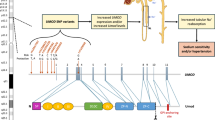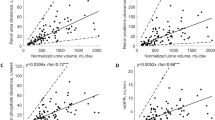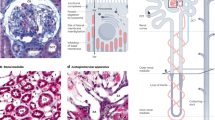Abstract
ALTHOUGH many extensive investigations in animals1–3 have demonstrated the existence of renal medullary hyperosmolality suggestive of a counter-current mechanism of urine concentration, direct evidence of medullary hyperosmolality in man has never been obtained hitherto. We have examined the tissue concentrations of sodium, potassium, urea and ammonia in human kidneys removed at operation or shortly after death, using standard techniques4.
This is a preview of subscription content, access via your institution
Access options
Subscribe to this journal
Receive 51 print issues and online access
$199.00 per year
only $3.90 per issue
Buy this article
- Purchase on SpringerLink
- Instant access to full article PDF
Prices may be subject to local taxes which are calculated during checkout
Similar content being viewed by others
References
Wirz, H., Hargitay, B., and Kuhn, W., Helv. Physiol. Pharmacol. Acta, 9, 196 (1951).
Ullrich, K. J., and Jarausch, K. H., Pflügers Archiv., 262, 537 (1956).
Gottschalk, C. W., and Mylle, M., Amer. J. Physiol., 196, 927 (1959).
Berlyne, G. M., and Macken, A., Clin. Sci., 22, 315 (1962).
Berlyne, G. M., and Hoerni, M. A. (in preparation).
Levitin, H., Goodman, A., Pigeon, G., and Epstein, F. H., J. Clin. Invest., 41, 1145 (1962).
Author information
Authors and Affiliations
Rights and permissions
About this article
Cite this article
BERLYNE, G., HOERNI, M. Urine-concentrating Mechanism in Man. Nature 199, 78 (1963). https://doi.org/10.1038/199078a0
Issue date:
DOI: https://doi.org/10.1038/199078a0



